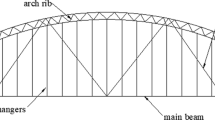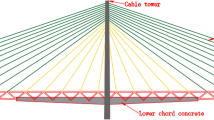Abstract
Improvements to the dynamic characteristics and stiffness of composite girder bridges are necessary to expand their applications and capabilities. The natural frequency of a bridge directly reflects the dynamic characteristics of a structure. From the calculation principle for the natural frequency, the natural frequencies of a bridge can be significantly increased if the load increases slightly while the structural stiffness increases significantly. Based on this, a new type of concrete-steel composite truss bridge is proposed. The new bridge has a reasonable new arrangement for the position of the concrete and steel, according to the bending moment law for continuous girders. The mechanical analysis of the new bridge shows that it has the characteristic of adding a small amount of load at a reasonable position, which can significantly improve the stiffness. Therefore, it is possible to achieve the purpose of improving the dynamic characteristics so that they are far better than those of a conventional composite truss bridge. To further study the dynamic characteristics of the new composite truss bridge, the finite element (FE) method was used to analyse the new bridges, and the results are compared with those of conventional composite truss bridges. Furthermore, several parameters that influence the dynamic characteristics of the new composite truss bridge were studied. Finally, the dynamic characteristics of the small-span new bridge were studied by finite element analysis (FEA) and experiment. The results show that the new composite truss bridges with different span arrangements and different second-stage dead loads always have better natural frequencies and stiffness advantages. Therefore, the new composite truss bridge is suitable for girder bridges with strict requirements for their stiffness and dynamic characteristics, especially for super-long span high-speed railway girder bridges.
Similar content being viewed by others
References
Hou ZM (2013) Theoretical analyses and model test for dynamic behaviors and damage identification of steel-concrete beam bridge. PhD Thesis, Beijing Jiaotong University, Beijing, China (in Chinese)
Ji BH, Fu ZQ (2016) Steel bridge. China Communications Press, Beijing, China (in Chinese)
JTG D60-2015E (2015) General specifications for design of highway bridges and culverts. JTG D60-2015E, China Communications Press, Beijing, China
Lebet JP, Hirt MA (2013) Steel bridges: Conceptual and structural design of steel and steel-concrete composite bridge. CRC Press, Boca Raton, FL, USA, 13–20
Li GH (2003) Stability and vibration of bridge structures (revised edition). China Railway Publishing House, Beijing, China, 291–300 (in Chinese)
Liu K, Lombaert G, Roeck GD, Chellini G, Nardini L, Salvatore W, Peeters B (2009) The structural behavior of a composite bridge during the passage of high-speed trains. Structural Engineering International 19(4):427–431, DOI: https://doi.org/10.2749/101686609789847082
Nie JG, Li FX, Fan JS, Kang HX (2012) Double composite action of large-span steel-concrete composite continuous box-girder bridges. Journal of Tsinghua University Science and Technology 52(02):133–138, DOI: https://doi.org/10.16511/j.cnki.qhdxxb.2012.02.019 (in Chinese)
Reis A, Pedro JJO (2011) Composite truss bridges: New trends, design and research. Steel Construction 4(3):176–182, DOI: https://doi.org/10.1002/stco.201110024
TB10091-2017 (2017) Code for design on steel structure of railway bridge. TB10091-2017, China Railway Publishing House, Beijing, China (in Chinese)
Tian ZJ, Liu YJ, Jiang L, Zhu WQ, Ma YP (2019) A review on application of composite truss bridges composed of hollow structural section members. Journal of Traffic and Transportation Engineering (English Edition) 6(1):94–108, DOI: https://doi.org/10.1016/j.jtte.2018.12.001
Ülker M, Karoumi R (2012) Influence of non-linear stiffness and damping on the train-bridge resonance of a simply supported railway bridge. Engineering Structures 41:350–355, DOI: https://doi.org/10.1016/j.engstruct.2012.03.060
Xu DY, Liu YQ, He J, Ma B (2011) Experimental study and numerical analysis of a composite truss joint. Journal of Constructional Steel Research 67(6):957–964, DOI: https://doi.org/10.1016/j.jcsr.2011.01.013
Xu JL, Sun SH (2011) Steel bridge. China Communications Press, Beijing, China, 263–275 (in Chinese)
Acknowledgments
The authors are grateful for the grants awarded by the Guangxi Key R & D Plan (No. Guangxi Sciences AB18126047) and the Systematic Project of Guangxi Key Laboratory of Disaster Prevention and Structural Safety (No. 2016ZDX0001). The grant have supported the works described in this paper.
Author information
Authors and Affiliations
Corresponding author
Rights and permissions
About this article
Cite this article
Xie, X., Huang, Y. & Qin, X. A New Composite Truss Bridge and a Study on Its Dynamic Characteristics with FE and Experimental Methods. KSCE J Civ Eng 25, 931–947 (2021). https://doi.org/10.1007/s12205-021-0655-z
Received:
Revised:
Accepted:
Published:
Issue Date:
DOI: https://doi.org/10.1007/s12205-021-0655-z




